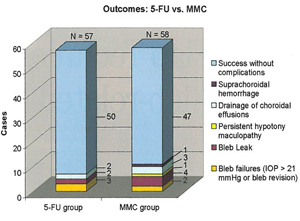Verteporfin-treated patients lost a mean of 1.3 letters at 12 months with no further damage at 24 months. Placebo-treated paitents lost a mean of 4.5 letters at 12 months and 5.2 letters at 24 months.
In the total study population, 86 verteporfin-treated patients (21 percent) lost six or more letters of contrast sensitivity at 24 months, compared with 94 patients given placebo (45 percent). Similarly, at 24 months, 27 verteporfin-treated patients (7 percent) and 24 patients given placebo (12 percent) lost 15 or more letters.
Researchers note that prevention of loss of contrast sensitivity represents an additional clinically relevant benefit for patients receiving photodynamic therapy.
Retina 2002;22:536-544
Rubin G, Bressler N, The Treatment of Age-Related Macular Degeneration with Photodynamic Therapy Study Group
5-FU vs. MMC in Primary Trabeculectomy
An Indiana University study suggests that intraoperative 5-fluorouracil (5-FU) is at least as effective as intraoperative topical mitomycin-C in reducing intraocular pressure of eyes undergoing primary trabeculectomy. (See chart).
This study randomized 115 eyes of 103 patients to one of two treatment groups in a single institution setting. Subjects' eyes underwent primacy trabeculectomy with either topical 5-FU (50 mg/ml for five minutes) (n=57) or topical MMC (0.2 mg/ml for two minutes) (n=58). If both eyes of a patient were enrolled, one eye would receive 5-FU while the fellow eye would receive MMC.
In eyes that completed a six-month follow up, researchers achieved a target IOP of 21 mmHg in 53 of 56 eyes (95 percent) in the 5-FU group and 54 of 57 eyes (95 percent) in the MMC group. At 12 months, 94 percent of the eyes in the 5-FU group met a target IOP of 21 mmHg compared to 89 percent of the eyes in the MMC group.
|
Am J Ophthalmol 2002;134:521-528
Wudunn D, Cantor L, Palanca-Capistrano A, Hoop J, Alvi N, Finley C, Lakhani V, Burnstein A, Knotts S
Contrast Sensitivity Drops Temporarily After LASIK
A general depression in contrast sensitivity follows LASIK, but it usually recovered in six months, reports a Hong Kong study team who observed 41 LASIK patients.
One of three surgeons at a local refractive surgery center performed all LASIK procedures using an Automated Corneal Shaper microkeratome (Bausch & Lomb) and the Technolas 217C excimer laser. The mean ablation zone diameter was 5.93 ±0.36 mm. For contrast sensitivity testing, observers used the Visual Stimulus Generator, VSG2/3 (Cambridge Research Systems, Kent, England).
Investigators collected data before LASIK and one week, on, three, and six months, and one year postop. The most affected frequencies were 1.5 and 3.4 cycles per degree. It took at least six months for the contrast sensitivity to recover to the preoperative level. The reduction in contrast sensitivity was greater for higher amounts of myopia. The observers noted that LASIK patients may have no problems reading or looking at a high-contrast visual acuity chart, but may experience difficulty in driving or recognizing faces because these involve medium- to low-contrast tasks.
J Cataract Refract Surg 2002;28:1774-1779
Chan J, Edwards M, Woo G, Woo V
Antibiotic Prophylaxis May Prevent Endophthalmitis
Three days of prophylactic ofloxacin significantly reduces the qualitative incidence of positive bacterial cultures before and after povidone iodine application and on completion of cataract surgery, say researchers at Stanford University.
A total of 93 eyes from 89 patients participated in this randomized, prospective study. They were randomized to a control group (48 eyes) or study group (44 eyes). All patients from both groups received topical ofloxacin 0.3% one hour before surgery, and a 5% povidone iodine scrub of the peri-orbital area before surgery. The patients in the study group received additional ofloxacin q.i.d. for three days before surgery. Investigators obtained conjunctival cultures at five separate points and inoculated the cultures in solid and liquid media.
Immediately before surgery, 42 percent of eyes in the control group and 19 percent of the eyes in the study group had positive conjunctival culture (p<0.05). Immediately after surgery, 34 percent of control group eyes and 14 percent of study group eyes had positive culture (p<0.05). Quantitatively, fewer bacteria were isolated from eyes in the study group compared with those in teh control group from culture samples that were obtained both before povidone iodine scrub and at the conclusion of surgery.
The researchers hypothesize that decreasing the number of bacteria on the lids and conjunctiva reduces the risk of developing endophthalmitis after surgery.
Ophthalmology 2002;109:2036-2041
Ta C, Egbert P, Singh K, Shriver E, Blumenkranz M, Mino de Kaspar H.
25-Gauge TSV System Reduces Operative Times
Although the infusion and aspiration rates of the 25-ga. instruments are lower than those for the 20-ga. high-speed vitrectomy system, researchers at the University of Southern California say that the user of the 25-ga. transconjunctival sutureless vitrectomy (TSV) system may reduce operative times of select cases that don't require the full capability of conventional vitrectomy.
Twenty eyes of 20 patients underwent a variety of vitreoretinal procedures using the 25-ga. TSV, including surgeries for idiopathic epiretinal membrane, macular hole, rhegmatogenous retinal detachment, branch retinal vein occlusion and diabetic vitreous hemorrhage. Twenty cases with similar diagnoses and severities were matched to provide comparison between duration of individual portions of the surgical procedures using the existing 20-ga. vitrectomy system.
With BSS, infusion and aspiration rates of the 25-ga. TSV system were reduced by an average of 6.9 and 6.6 times, respectively, compared with the 20-ga. system.
Mean and total operative time was significantly greater for the 20-ga. high-speed cutter (26 mins. 7 secs.) than for the 25-ga. vitrectomy system (17 mins. 17 secs.) (p=0.011).
Ophthalmology 2002;109:1807-1813
Fujii G, deJuan. Jr., E, Humayun M, Pieramici D, Chang T, Ng E, Barnes A, Wu S, Sommerville D.




